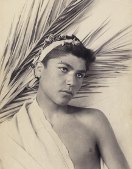Da: Anonimo, The photographic Salon / Il salone di fotografia [12 ottobre 1893] [1]
| (...) The fine series of figure
studies of Count Von Gloeden, as at Pall
Mall, compel attention, because, though from the nude, the artist has
avoided giving anything that is offensive to good taste. |
(...) La
bella serie di studi di figura, del conte von Gloeden, esposta a Pall
Mall, richiama l'attenzione perché, nonostante siano studi di nudo,
l'artista ha evtato di darci checchessia che possa offendere il buon
gusto.
|
These are mainly
gelatine-chloride prints in which detail is not
lacking, though in none is this so pronounced as to detract from the
artistic treatment of the subject, for that an artist has produced them
is stamped upon each [2].
|
Si
tratta soprattutto di stampe su gelatina al cloruro <d'argento,>
in cui non c'è carenza di dettaglio, per quanto in nessuna ciò sia
tanto pronunciato da distrarre dal trattamento artistico del soggetto,
poiché in ciascuna c'è l'impronta del fatto d'essere opera d'un artista [2]. |
| As figure studies the series
must be exceedingly helpful to artists,
for they may, with-out any slavish copying, get hints that should
supplement the posing of the model in any individual case. |
Come
studi di figura, la serie sarà certo estremamente utile agli artisti,
che potranno, senza copiare pedissequamente, ottenere idee che
dovrebbero in
ogni singolo caso integrare la posa del modello.
|
| The grace and beauty of the
human form is splendidly expressed, and in
those examples in which scenery forms a part the combination is most
happy. Alma-Tadema might have composed 97, in which three figures
stand, partially draped, gracefully posed inside a parapet above a
rocky shore, the central figure pointing seaward, and of each
individual is a view only obtained from the rear, a method of treatment
which is not at all inartistic or so incongruous as it might have
proved in less able hands. |
La grazia e la bellezza della
forma umana
vi sono espresse splendidamente, in modo particolarmente
felice negli esempi in cui l'ambientazione forma parte della
combinazione. Alma-Tadema stesso potrebbe avere composto la foto n. 97 [3], in cui tre figure stanno
in piedi parzialmente drappeggiate, in posa aggraziata davanti a un
parapetto che dà su una riva rocciosa, con la figura centrale che
indica il mare, e di ogni individuo si ha una vista solo da
dietro, un metodo di trattamento che non è affatto inartistico o tanto
incongruo quanto avrebbe potuto risultare in mani meno abili.
|


La prima delle
due immagini citate nel testo.
|
A picture of very considerable
power is that of a female, partially
draped, figure at the foot of an aloe, the large leaves of which stand
sharply against and cut the sky clearly, the composition being
admirable, and the repose of the figure very easy.
|
Un'immagine
di considerevolissima potenza è quella d'una figura femminile,
parzialmente drappeggiata, ai piedi di un'agave, le cui grandi foglie
si stagliano nitidamente contro il cielo e lo tagliano nettamente: la
composizione è ammirevole, e il rilassamenteo della figura molto
naturale. |
| Perhaps the colour
of the print is deeper than many workers would have chosen, but the
purpose of the artist is probably more thoroughly fulfilled by this
than in any other way, and that this is so is perhaps evidenced by the
fact that it has gone to the public eye in this way. |
Forse
il colore della stampa è più cupo di quello che molti sviluppatori
avrebbero scelto, ma l'intento dell'artista è probabilmente realizzato
in modo più completo in questo modo piuttosto
che in altri, e il fatto che le cose stiano così è evidenziato dal
fatto che questa stampa è andata agli occhi del pubblico in queste
condizioni.
|
| Titles to each picture would have been aids so as to have given them point and force. (...) |
Un titolo per ogni immagine sarebbe stato d'aiuto nel dare senso e forza. (...) |


La seconda immagine analizzata nel testo.
----------------------------------
[Fare
clic qui per l'indice delle pagine su Gloeden e Plueschow]
-------------------------------------
L'autore ringrazia fin
d'ora chi vorrà aiutarlo a trovare immagini e ulteriori dati su
persone, luoghi e fatti descritti in questa pagina, e chi gli segnalerà
eventuali errori in essa contenuti.
|
Note
[1] Anonimo, The photographic salon, “Photography”, n. 257, vol.
V, October 12 1893, pp. 644-647, a p. 646. (Ringrazio Alfio Barca per l'invio
dell'articolo).
Il
nome di Gloeden sarebbe stato ancora menzionato, elencando gli artisti
esposti, in:
"Photography", n. 262, vol. V, Nov. 16 1893, alle pp. 720 e
721, entrambe le volte come: "Count
Gloeden".
Questo
articolo è una recensione relativa alla partecipazione di Gloeden a
un'esposizione di fotografia a Londra, nel 1893, che gli valse una
medaglia e suscitò notevole interesse.
[2] L'anonimo critico sta intervenendo nel dibattito dell'epoca secondo cui la fotografia sarebbe solo uno
strumento tecnico che si limita a "fotocopiare" la realtà. Perciò non
può essere classificata come arte, perché l'arte richiede anche
astrazione dalla realtà.
[3] In realtà l'influsso potrebbe essere andato anche in senso inverso, dato che già nel 1883 Alma-Tadema possedeva fotografie di Wilhelm von Plüschow (così Elizabeth Prettejohn et all, Sir Lawrence Alma-Tadema, Rizzoli, New York 1997, p. 166, come riportato in: Donald Rosenthal, The photographs of Frederick Rolfe,
Asphodel editions, North Pomfret 2008, p. 114).
Questa possibilità
andrebbe esaminata, visto che molte foto di Gloeden e colleghi sono
state trovate fra le carte di pittori suoi contemporanei.
Del resto le
recensioni all'opera di Gloeden dicono espressamente che le sue foto possono essere un
ausilio per gli artisti.
|




